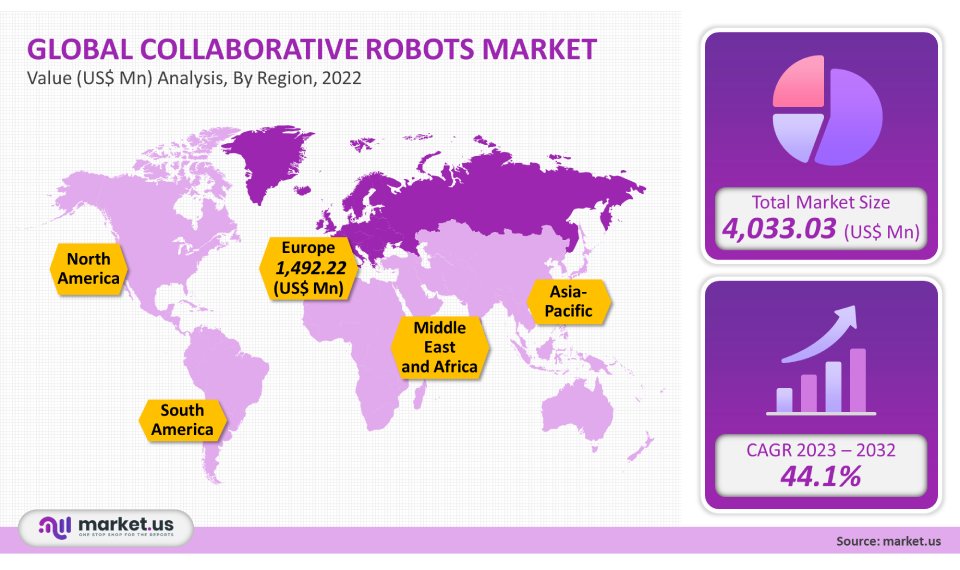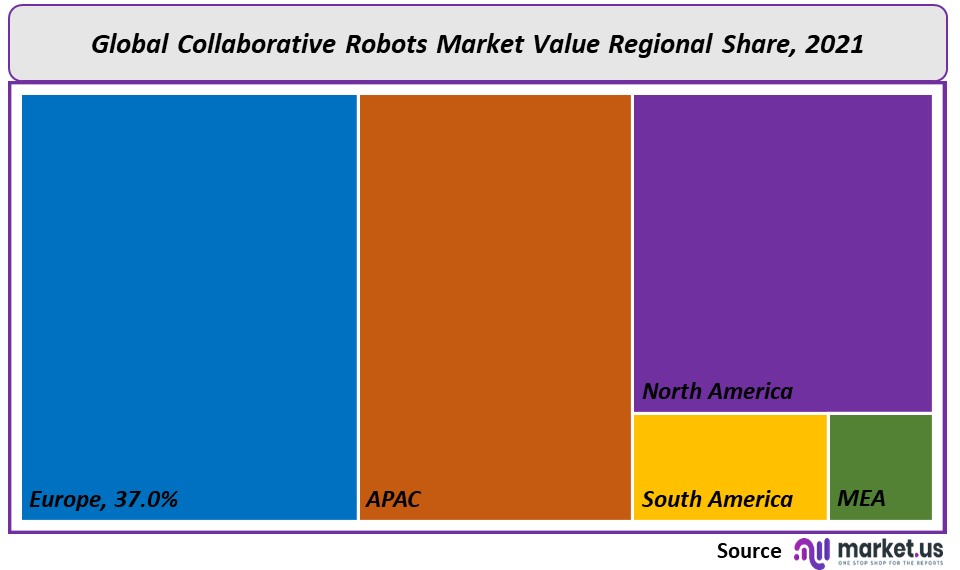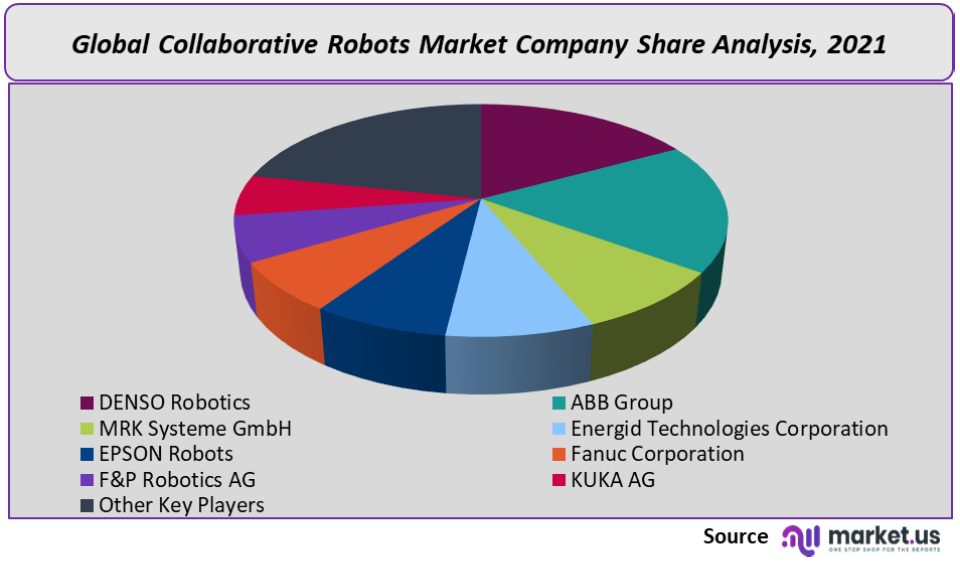Global Collaborative Robots Market By Payload Capacity, By Application, By Vertical, By Region and Companies - Industry Segment Outlook, Market Assessment, Competition Scenario, Trends and Forecast 2022-2032
- Published date: Nov 2021
- Report ID: 17838
- Number of Pages: 354
- Format:
- keyboard_arrow_up
Collaborative Robots Market Overview
The Collaborative Robots Market size is expected to be worth around USD 224.19 billion by 2032 from USD 4.03 billion in 2021, growing at a CAGR of 44.1% during the forecast period 2022 to 2032.
The cobot or collaborative robot is designed to interact and collaborate with humans in a shared space. Growth can be attributed to the growing acceptance of cobots in Small and Medium Enterprises (SMEs), and investments in automation in manufacturing processes. Robots working alongside humans in areas like smart parts and electronic product assembly are further fueling demand.
Global Collaborative Robots Market
Payload Capacity Analysis
Based on payload, the market for collaborative robots can be divided into segments of up to 5 kg and 10 kg respectively. Cobots with a payload of up to 5 kg accounted for the largest share in 2021, which was due to the machine’s flexibility and lightweight.
Cobots that can carry more than 10kg payload are expected to experience significant growth. This is because they are capable of handling larger tasks, which require precision, reliability, and collaboration with heavier-weight processes. Robotics are expected to experience an exponential growth rate of 46.2% during the forecast period.
Application Analysis
Further sub-categories of the application segment include pick and put, handling and packaging, quality testing, and machine tending. Because it is possible to combine both repetitive and more difficult assembly work, the assembly segment held the largest market share in 2021.
The forecast period will see the growth of the pick-and-place robotics segment driven by increasing adoption and application. To reduce shrinkage and increase accuracy, the co-robots are used for pick and places across verticals. Pick-and-place robots are small and lightweight and can be deployed in tight spaces.

Vertical Analysis
According to vertical segmentation, the market is divided into automotive, food & beverage, electronics, plastic and metal and machinery, pharmaceuticals, furniture and other equipment, and others. The market share held by the automotive industry was 24% in 2021, and it is expected that it will lead over the forecast period. It is anticipated that key factors like production downtime reduction and floor space reduction will boost growth during the forecast period.
Automation is becoming more popular in order to cut down on time and costs. This has prompted the adoption of robotic materials handling equipment within the automotive industry. Innovation will be the key to the future of the automotive market. New metals and chemicals are being introduced that improve cost-efficiency, weight reduction, and lower manufacturing overheads. Many technology integrators are emerging in the market and they will be a strong competitor to the established automobile manufacturers.
Key Market Segments
Payload Capacity
- Up to 5kg
- Up to 10kg
- Above 10kg
Application
- Assembly
- Handling
- Pick & Place
- Quality Testing
- Packaging
- Gluing & Welding
- Machine Tending
- Others
Vertical
- Food & Beverage
- Automotive
- Plastic & Polymers
- Furniture & Equipment
- Electronics
- Metal & Machinery
- Pharma
- Others
Market Dynamics
The demand for higher payload tasks is expected to rise. Increased industry installation has been due to the cobots’ ability to work with employees in an open environment. Co-robots come equipped with software, advanced sensors, and End of Arm Toolings (EOATs), which help to prevent injuries.
Technological advances have resulted in significant advancements in the robotic industry. These machines were costly at first and limited in functionality such as fixed axis and fixed rotation angles. Modern-day robots are capable and efficient in performing complex tasks, but they can also be purchased at a much lower price due to technological advancements. A robot can also deliver a rapid Return on Investments (ROI), thanks to its ability to optimize overall expenditures and increase the production rate.
The deployment of robots in the industry has led to a reduction in the number of workplace accidents and injuries. Robots have also helped increase the quality of goods and profit for many businesses. Statistics and surveys confirm the positive results of companies and organizations that have adopted collaborative robots, which have seen huge financial reimbursements.
Because of their attractive ROI, industrial robots are in high demand across many industries. The fastest-growing segment for cobots is expected to be automotive, electronics, packaging, assembling, logistics, machine tooling, and logistics.
Amazon, a giant in e-commerce, and retailers are already using robotic technologies. These e-retailers have embraced robotics to help their workers in warehouses, which plays a key role in the supply chain. Equipment manufacturers are developing robots for their logistic systems in response to the logistics sector’s increased interest in collaborative robotics. In turn, they reduce technology expenditures and improve robotic capabilities to service the exact client requirements.
Regional Analysis
Europe is a key region for revenue generation and held a significant market share at 37% in 2021. The enormous use of cobots across different verticals like electronics, logistics, and inspection is responsible for the region’s growth. Cobot technology has many benefits, including increased collaboration and more efficient manufacturing optimization.
In the Asia Pacific, there is a growing focus on precision and quality cobots. Therefore, more robots are being deployed in the region to ensure that they meet these standards. The technology’s ability produces better quality products, higher efficiency, lower wastage, standard products and reduced wastage is expected to significantly increase the adoption rate for collaborative robots during the forecast period. With a greater focus on automation, the adoption of artificial intelligence, along with all the necessary technological developments, the market has the potential to grow quickly over the forecast period.

Key Regions and Countries covered іn thе rероrt:
- North America
- US
- Canada
- Mexico
- Europe
- Germany
- UK
- France
- Italy
- Russia
- Spain
- Rest of Europe
- APAC
- China
- Japan
- South Korea
- India
- Rest of Asia-Pacific
- South America
- Brazil
- Argentina
- Rest of South America
- MEA
- GCC
- South Africa
- Israel
- Rest of MEA
Market Share Analysis
Partnerships are a way for players to expand their product range and gain an advantage in the market. Hyundai Robotics, a branch of Hyundai Heavy Industries Holdings, and KUKA AG forged strategic cooperation in 2018. KUKA Robotics Korea Co. Ltd. and KUKA AG, the parent company, the latter has been able to increase the range of products it offers in Korean-speaking areas thanks to their cooperation.

Key Market Players
- DENSO Robotics
- ABB Group
- MRK Systeme GmbH
- Energid Technologies Corporation
- EPSON Robots
- Fanuc Corporation
- F&P Robotics AG
- KUKA AG
- Other Key Players
For the Collaborative Robots Market research study, the following years have been considered to estimate the market size:
Attribute Report Details Historical Years
2016-2020
Base Year
2021
Estimated Year
2022
Short Term Projection Year
2028
Projected Year
2023
Long Term Projection Year
2032
Report Coverage
Competitive Landscape, Revenue analysis, Company Share Analysis, Manufacturers Analysis, Volume by Manufacturers, Key Segments, Key company analysis, Market Trends, Distribution Channel, Market Dynamics, COVID-19 Impact Analysis, strategy for existing players to grab maximum market share, and more.
Regional Scope
North America, Europe, Asia-Pacific, South America, Middle East & Africa
Country Scope
United States, Canada and Mexico, Germany, France, UK, Russia and Italy, China, Japan, Korea, India and Southeast Asia, Brazil, Argentina, Colombia etc.Saudi Arabia, UAE, Egypt, Nigeria and South Africa
Frequently Asked Questions (FAQ)
Q: What is the size of the Collaborative Robots market in 2021?The Collaborative Robots market size was US$ 4,033.03 million in 2021.
Q: What is the projected CAGR at which the Collaborative Robots market is expected to grow at?The Collaborative Robots market is expected to grow at a CAGR of 44.1% (2023-2032).
Q: List the segments encompassed in this report on the Collaborative Robots market?Market.US has segmented the Collaborative Robots market by geographic (North America, Europe, APAC, South America, and Middle East and Africa). By Payload Capacity, market has been segmented into Up to 5kg, Up to 10kg, and Above 10kg. By Application, the market has been further divided into Assembly, Handling, Pick & Place, Quality Testing, Packaging, Gluing & Welding, Machine Tending, and Others. By Vertical, market has been segmented into Food & Beverage, Automotive, Plastic & Polymers, Furniture & Equipment, Electronics, Metal & Machinery, Pharma, and Others.
Q: List the key industry players of the Collaborative Robots market?DENSO Robotics, ABB Group, MRK Systeme GmbH, Energid Technologies Corporation, EPSON Robots, Fanuc Corporation, F&P Robotics AG, KUKA AG, and Other Key Players engaged in the Collaborative Robots market.
Q: Which region is more appealing for vendors employed in the Collaborative Robots market?Europe is accounted for the highest revenue share of 37%. Therefore, the Collaborative Robots industry in Europe is expected to garner significant business opportunities over the forecast period.
Q: Name the key areas of business for Collaborative Robots?U.S., Canada, Mexico, U.K., Germany, France, China, Japan, India, and Brazil are key areas of operation for Collaborative Robots Market.
Q: Which segment accounts for the greatest market share in the Collaborative Robots industry?With respect to the Collaborative Robots industry, vendors can expect to leverage greater prospective business opportunities through the up to 5 kg segment, as this area of interest accounts for the largest market share.
![Collaborative Robots Market Collaborative Robots Market]()
- DENSO Robotics
- ABB Group
- MRK Systeme GmbH
- Energid Technologies Corporation
- EPSON Robots
- FANUC Corporation Company Profile
- F&P Robotics AG
- KUKA AG
- Other Key Players
- settingsSettings
Our Clients
|
Single User
$5,999
$2,999
USD / per unit
save 50% |
Multi User
$7,999
$3,499
USD / per unit
save 55% |
Corporate User
$12,999
$4,499
USD / per unit
save 65% | |
|---|---|---|---|
| e-Access | |||
| Data Set (Excel) | |||
| Company Profile Library Access | |||
| Interactive Dashboard | |||
| Free Custumization | No | up to 10 hrs work | up to 30 hrs work |
| Accessibility | 1 User | 2-5 User | Unlimited |
| Analyst Support | up to 20 hrs | up to 40 hrs | up to 50 hrs |
| Benefit | Up to 20% off on next purchase | Up to 25% off on next purchase | Up to 30% off on next purchase |
| Buy Now ($ 2,999) | Buy Now ($ 3,499) | Buy Now ($ 4,499) |









